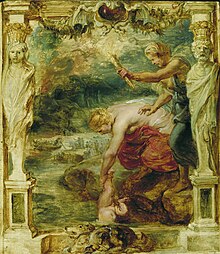Achilles' heel

An Achilles' heel[1] (or Achilles heel[2][3]) is a weakness despite overall strength, which can lead to downfall. While the mythological origin refers to a physical vulnerability, idiomatic references to other attributes or qualities that can lead to downfall are common.

Although the death of Achilles was predicted by Hector in Homer's Iliad, it does not actually occur in the Iliad, but was described in later Greek and Roman poetry and drama[4] concerning events after the Iliad, later in the Trojan War. In the myths surrounding the war, Achilles was said to have died from a wound to his heel,[5][6] ankle,[7] or torso,[5] which was the result of an arrow—possibly poisoned—shot by Paris.[8] The Iliad may purposefully suppress the myth to emphasise Achilles' human mortality and the stark chasm between gods and heroes.[9]
Classical myths attribute Achilles's invulnerability to his mother Thetis having treated him with ambrosia and burned away his mortality in the hearth fire except on the heel, by which she held him. Peleus, his father, discovered the treatment and was alarmed to see Thetis holding the baby in the flames, which offended him and made her leave the treatment incomplete.[10] According to a myth arising later, his mother had dipped the infant Achilles in the river Styx, holding onto him by his heel, and he became invulnerable where the waters touched him—that is, everywhere except the areas of his heel that were covered by her thumb and forefinger.[11]
As expression
[edit]As an expression meaning "area of weakness, vulnerable spot", the use of "Achilles' heel" dates only to 1840, with implied use in Samuel Taylor Coleridge's "Ireland, that vulnerable heel of the British Achilles!" from 1810 (Oxford English Dictionary).[12]
Anatomy
[edit]The oldest-known written record of the Achilles tendon being named after Achilles is in 1693 by the Flemish/Dutch anatomist Philip Verheyen. In his widely used text Corporis Humani Anatomia he described the tendon's location and said that it was commonly called "the cord of Achilles".[13][14]
The large and prominent tendon of the gastrocnemius, soleus, and plantaris muscles of the calf is called the tendo achilleus or Achilles tendon. This is commonly associated with the site of Achilles's death wound. Tendons are avascular, so such an injury would be unlikely to be fatal if the arrow were not poisoned.[15]
See also
[edit]- Achilles – Greek mythological hero
- Achilles tendon – Tendon at the back of the lower leg
- Balder – Norse deity in Norse mythology
- Duryodhana in the Mahabharatha
- Esfandiyār – Persian mythological hero of the epic poem Shahnameh in the Shahnameh
- Kryptonite – Fictional element from Superman stories
- Siegfried – Fictional character in Germanic and Norse mythology in the Nibelungenlied
- Single point of failure – A part whose failure will disrupt the entire system
- Squatting position – Resting posture where the weight of the body is on the feet but the knees and hips are bent
References
[edit]- ^ "Achilles' heel | Merriam-Webster".
- ^ "Achilles heel | meaning in the Cambridge English Dictionary". dictionary.cambridge.org. Retrieved 2019-09-29.
- ^ "Achilles heel | Definition of Achilles heel by Lexico". Lexico Dictionaries | English. Archived from the original on September 29, 2019. Retrieved 2019-09-29.
- ^ E.g. Ovid, Metamorphoses 12.580–619.
- ^ a b "Who was Achilles?". The British Museum Blog. 2019-10-15. Retrieved 2019-12-24.
- ^ "Ancient History". HISTORY. Retrieved 2019-12-24.
- ^ "Apollodorus, Epitome, book e, chapter 5, section 3".
- ^ See P. J. Heslin, The Transvestite Achilles: Gender and Genre in Statius’ Achilleid, Cambridge: Cambridge University Press: 2005, 166–169.
- ^ Nelson, Thomas J. (2021). "Achilles' Heel: (Im)mortality in the Iliad". Omnibus. 82: 7–9.
- ^ Apollonius, Argonautica 4.869–872
- ^ Statius, Achilleid 1.122f., 269f., 480f.
- ^ "Home : Oxford English Dictionary". www.oed.com. Archived from the original on 2021-12-07. Retrieved 2019-09-29.
- ^ Veheyen, Philip (1693), Corporis humani anatomia, Leuven: Aegidium Denique, p. 269, retrieved 12 Mar 2018,
Vocatum passim chorda Achillis, & ab Hippocrate tendo magnus. (Appendix, caput XII. De musculis pedii et antipedii, p. 269)
- ^ Klenerman, L. (April 2007). "The early history of tendo Achillis and its rupture". The Journal of Bone and Joint Surgery. British Volume. 89-B (4): 545–547. doi:10.1302/0301-620X.89B4.18978. PMID 17463129.
- ^ Anagnostopoulou, Sophia; Mavridis, Ioannis (2013). "Achilles' death: anatomical considerations regarding the most famous trauma of the Trojan War". J Trauma Acute Care Surg. 74 (3): 946–947. doi:10.1097/TA.0b013e31828272ad. PMID 23425764.
